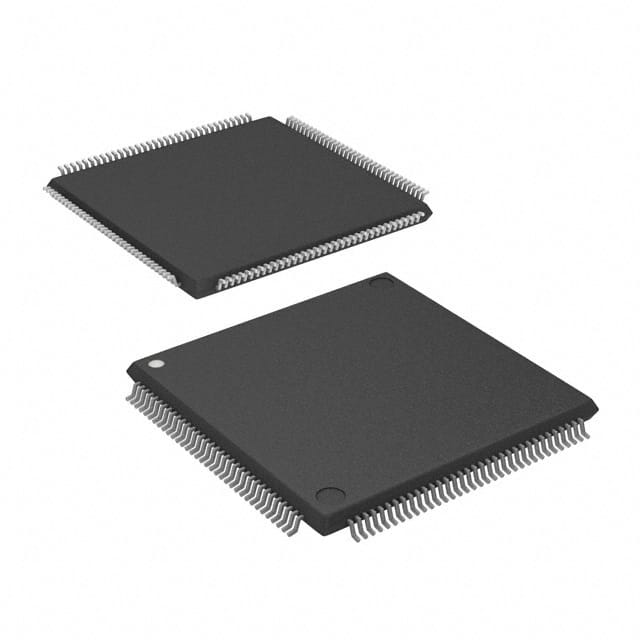EP1C6T144C7
Product Overview
- Category: Programmable Logic Device (PLD)
- Use: EP1C6T144C7 is a PLD that can be programmed to perform various logic functions.
- Characteristics: It offers high performance, low power consumption, and flexibility in designing digital circuits.
- Package: The EP1C6T144C7 comes in a 144-pin Thin Quad Flat Pack (TQFP) package.
- Essence: This PLD allows users to implement complex digital systems using programmable logic.
- Packaging/Quantity: Each package contains one EP1C6T144C7 PLD.
Specifications
- Logic Elements: The EP1C6T144C7 has 5,760 logic elements.
- Embedded Memory: It includes 288 Kbits of embedded memory.
- I/O Pins: There are 101 I/O pins available for connecting external devices.
- Clock Networks: The device provides 4 global clock networks.
- Operating Voltage: It operates at a voltage range of 1.15V to 1.25V.
- Speed Grade: The EP1C6T144C7 is available in different speed grades, such as -7, -10, and -12.
Pin Configuration
The EP1C6T144C7 has a total of 144 pins. Here is a detailed pin configuration:
- Pin 1: GND
- Pin 2: IOB_0
- Pin 3: IOB_1
- ...
- Pin 144: VCCIO
Functional Features
- Programmability: The EP1C6T144C7 can be programmed to implement various logic functions, allowing for flexible circuit design.
- High Performance: It offers fast operation and efficient execution of logic functions.
- Low Power Consumption: The device is designed to minimize power consumption, making it suitable for battery-powered applications.
- Versatility: EP1C6T144C7 can be used in a wide range of applications, including telecommunications, industrial control systems, and consumer electronics.
Advantages and Disadvantages
Advantages: - Flexibility in circuit design - High performance - Low power consumption - Versatile application possibilities
Disadvantages: - Limited logic elements compared to higher-end PLDs - Higher cost compared to simpler logic devices
Working Principles
The EP1C6T144C7 operates based on the principles of programmable logic. It consists of configurable logic blocks (CLBs), embedded memory blocks, I/O pins, and interconnect resources. Users can program the device using hardware description languages (HDL) or schematic entry tools to define the desired logic functions. Once programmed, the PLD executes the logic functions by routing signals through the CLBs and interconnect resources.
Detailed Application Field Plans
The EP1C6T144C7 can be applied in various fields, including:
- Telecommunications: Used in network routers, switches, and communication equipment.
- Industrial Control Systems: Employed in automation systems, motor control, and process control.
- Consumer Electronics: Utilized in digital TVs, set-top boxes, and gaming consoles.
- Automotive: Applied in automotive control units, infotainment systems, and driver assistance systems.
Alternative Models
Here are some alternative models that offer similar functionality:
- EP1C12Q240C8: Offers higher logic capacity with 12,288 logic elements.
- EP1C20F324I7: Provides more I/O pins with 202 pins.
- EP1C3T100C8N: Suitable for low-cost applications with 3,072 logic elements.
These alternative models can be considered based on specific project requirements and desired features.
Word count: 411 words
Lista 10 Vanliga frågor och svar relaterade till tillämpningen av EP1C6T144C7 i tekniska lösningar
Sure! Here are 10 common questions and answers related to the application of EP1C6T144C7 in technical solutions:
Q1: What is EP1C6T144C7? A1: EP1C6T144C7 is a specific model of Field-Programmable Gate Array (FPGA) manufactured by Intel. It offers 6,000 logic elements and comes in a 144-pin package.
Q2: What are the typical applications of EP1C6T144C7? A2: EP1C6T144C7 can be used in various technical solutions such as digital signal processing, embedded systems, robotics, industrial automation, and telecommunications.
Q3: How does EP1C6T144C7 differ from other FPGAs? A3: EP1C6T144C7 stands out due to its specific features like the number of logic elements, pin count, and performance capabilities. It's important to compare these specifications with other FPGAs to determine the best fit for your application.
Q4: Can EP1C6T144C7 be programmed? A4: Yes, EP1C6T144C7 is a programmable device. It can be configured using Hardware Description Languages (HDLs) like VHDL or Verilog.
Q5: What tools are required to program EP1C6T144C7? A5: To program EP1C6T144C7, you will need a development board or programmer that supports this specific FPGA model. Additionally, you will require software tools provided by Intel, such as Quartus Prime, to write and compile your code.
Q6: What voltage levels does EP1C6T144C7 support? A6: EP1C6T144C7 operates at a voltage range of 1.15V to 1.25V for core logic and 3.0V to 3.6V for I/O pins.
Q7: Can EP1C6T144C7 interface with other components or devices? A7: Yes, EP1C6T144C7 can interface with various components and devices through its I/O pins. It supports different protocols like SPI, I2C, UART, and more.
Q8: Is EP1C6T144C7 suitable for high-speed applications? A8: EP1C6T144C7 has a maximum operating frequency that depends on the design and implementation. It can be used in high-speed applications, but it's important to consider the specific requirements and constraints of your project.
Q9: Can EP1C6T144C7 be reprogrammed multiple times? A9: Yes, EP1C6T144C7 is a reprogrammable FPGA. You can modify and reconfigure its functionality multiple times as needed.
Q10: Where can I find documentation and support for EP1C6T144C7? A10: Intel provides comprehensive documentation, datasheets, application notes, and user guides for EP1C6T144C7 on their official website. Additionally, online forums and communities dedicated to FPGA development can provide valuable support and resources.


